African lions, known scientifically as Panthera leo, are one of the most recognizable mammals found on the continent. Roaming the savannahs and woodlands, these carnivores play a critical role in their ecosystems as apex predators. Typically, they reside in groups called prides, a strategic formation for hunting and survival. Adult lions can measure between 4.5 to 6.5 feet in length, not including their tails, which add 26.25 to 39.5 inches and weigh between 265 to 420 pounds.
Despite their might and presence in popular culture, the status of African lions is one of concern. Classified as ‘Vulnerable’ by the International Union for Conservation of Nature (IUCN), the population trend of this majestic species is on the decline. Threats such as habitat loss, conflict with humans, and poaching have decreased numbers, underscoring the need for informed conservation efforts to ensure their survival for future generations.
Profile of the African Lion

Divided into several different subspecies, the African lion is a large and magnificent feline carnivore. It is taller at the shoulder than tigers (123 centimeters in large males, 91 centimeters in females) and weighs up to 250 or 180 kilograms, respectively, for males and females.
Average weights are closer to 181 and 126 kilograms, however. African lions measure from 1.4 to 2 meters long, and males sport a regal-looking mane, whose thickness and color vary by region.
Scientific Name: Panthera leo
Classification: Mammal, Big Cat
Size & Weight:
- Adult lions are second only to tigers in size among big cats.
- Males typically weigh between 150-250 kg (330-550 lbs).
- Females are generally smaller, weighing 120-182 kg (265-400 lbs).
Physical Attributes:
- Coat: Yellow-gold in adults, with juveniles displaying light spots that fade over time.
- Males have distinctive manes.
Reproduction: Lions have complex reproduction behaviors essential for the continuation of the species.
Diet: Carnivorous, with a diet that includes various prey from insects to large ungulates.
Sound: Known for their powerful roar, audible up to eight kilometers (five miles) away.
Range: Predominantly found in Sub-Saharan Africa.
Strength & Behavior:
- Lions are notable for their strength and courage.
- They exhibit social behaviors, often living and hunting in groups.
| Category | Information |
|---|---|
| Scientific Name | Panthera leo |
| Population Size | 23,000 – 39,000 mature individuals |
| Distribution/Geography | Sub-Saharan Africa, Gir Forest in India |
| Habitat | Grassy plains, savannas, scrub bordering rivers, open woodlands with bushes |
| Appearance | Big wild cat, short tawny-colored fur, white underparts, black tuft on tail, males with manes |
| Sexual Dimorphism | Males have manes, which range in color from black to blond |
| Mane Development | Begins at the age of 3 years |
| Cubs | Grayish coat with brown markings at birth, fading by 3 months, some retain spots on their stomach |
| Social Structure | Live in groups called prides, up to 3 males, multiple lionesses, and their young |
| Activity | Mostly nocturnal, peak activity after dusk, socializing, grooming, and hunting |
| Hunting | Primarily done by females in groups, males defend territory |
| Vocalizations | Growling, snarling, meowing, roaring, purring, puffing, bleating, humming |
| Diet | Hypercarnivores, hunt zebras, antelopes, gazelles, deer, buffalos, etc., scavenge when needed |
| Mating Habits | Polygynous, breed year-round with a peak during the rainy season |
| Gestation Period | 110 to 119 days |
| Cubs Per Litter | 3-6 cubs on average |
| Weaning | Occurs at 6-7 months |
| Maturation | Males at 5 years, females at 2.5-3 years |
| Population Threats | Trophy hunting, habitat loss, human conflict, diseases from domestic animals |
| Conservation Status | Vulnerable (VU) according to IUCN Red List |
| Ecological Niche | Control populations of herbivorous animals, maintaining balance in the ecosystem |
| Interesting Facts | Lions are social, rubbing heads and sleeping in groups; males have identifying manes; second largest feline next to tigers |
Habitat & Location
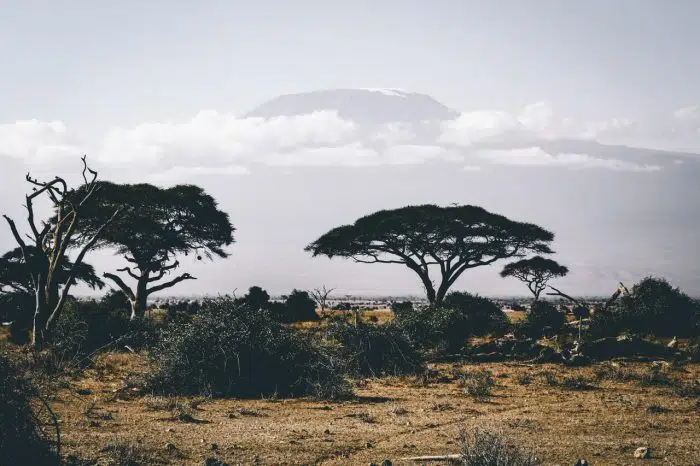
African lions are found in favorable habitats throughout sub-Saharan Africa. Formerly, they were found along the Mediterranean coast, throughout the Middle East, eastern and southern Africa and Europe. Lions are found in grassland and savannah habitats, scrubland, bush, and open forests.
These regal predators are adept at navigating the scrub and open woodlands of regions like Tanzania, which offer optimal conditions for hunting.
Although once widespread across multiple continents, they presently inhabit less than 10% of their historic range, absent from rainforests and deserts. Adaptability to various environments has proved essential for survival, but they are now mainly restricted to protected areas within their remaining domains.
See Related: Spotted Hyena
Dimensions and Growth Patterns of Lions
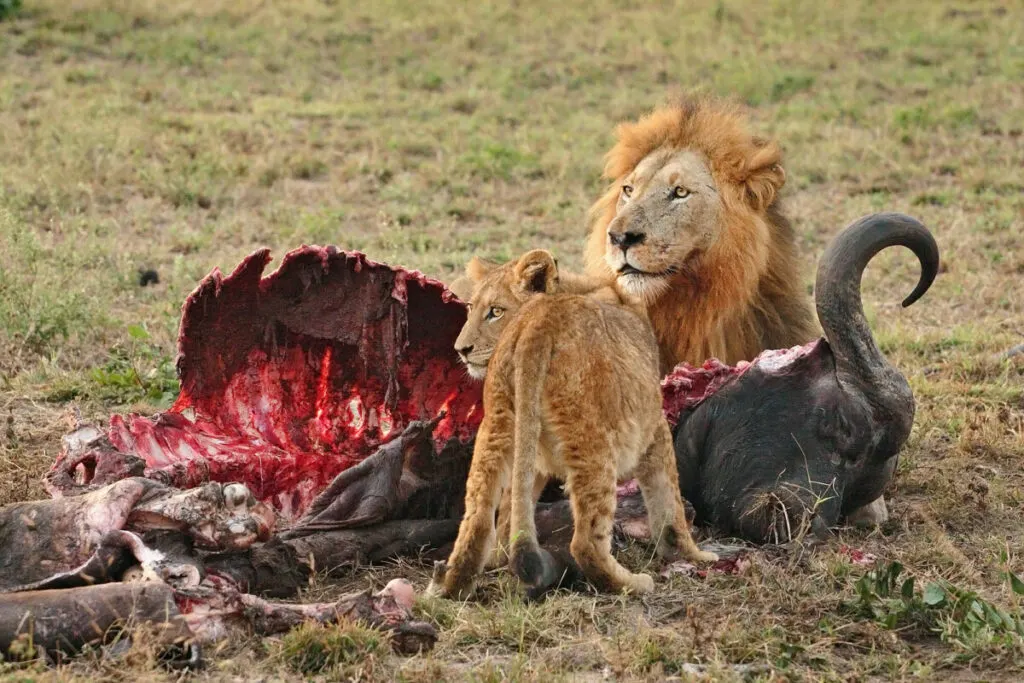
Physical Structure and Stature
Lions exhibit a robust structure with considerable forelimb strength, substantial jaws, and pronounced dentition, favoring their predatory nature. These characteristics are further accentuated by their golden-yellow fur and, in males, a distinguishing mane that varies in hue from light blond to deep black, signaling age, genetic factors, and hormonal influences.
Growth Development in Lion Cubs
Cub maturation involves a gradual loss of juvenile spotting and weight gain until reaching adult size. This transformation is so profound that, in the absence of their distinctive fur, lion and tiger physiques are nearly indistinguishable, save for the expertise of specialists.
Average Dimensions
Adult lions, standing up to 4 feet at the shoulder, command a presence through stature and length. Males may measure up to 10 feet, including their hefty tails, and tip the scales between 330 and 550 pounds. Female lions, though marginally smaller, also boast formidable dimensions, extending up to 9 feet long and weighing between 265 and 395 pounds.
Habitats and Adaptability
Preferring open plains or dense brush, lions adapt to various African environments, except for humid, equatorial jungles. A small number reside in India’s Gir Forest, differentiating from their African counterparts.
Predation and Diet
These carnivores predominantly hunt large prey, from zebras to wildebeests, with adults capable of tackling creatures that span a considerable weight range. In dire times, their diet diversifies to include smaller species. Confrontations with other predators, such as hyenas only cats, can lead to competitive scavenging situations.
Reproductive Dynamics
Lions follow a biennial reproductive pattern, with females receptive multiple times annually unless they are already nurturing their young. Each gestation yields up to four cubs who, despite a high mortality rate in their initial years due to various threats, nurse for six months while integrating meat into their diet by the third month.
Lifespan Variability
While lions in managed care environments may reach their early twenties, those in the wild often have shorter lifespans, with males rarely surpassing 12 years and females potentially reaching 16. Preservation efforts have become critical as lion numbers have dropped, with only about 20,000 remaining in the wild.
Conservation and Coexistence
Few lions die peaceful deaths – other lions or humans either kill most. It is human activity, however, which presents an actual threat to the species’ survival. Lions are hunted for sport and to reduce risks to domestic animals that they may hunt from time to time.
Habitat destruction also has its part to play in the decline of these spectacular carnivores, as growing populations of people appropriate more land for their cattle, goats, and farming activities. Humans have fragmented some 75% of the savannah over the past half-century.
The African lion is probably not in imminent danger of extinction, but its range could be drastically reduced if conservation measures do not successfully reverse current trends.
The lion’s existence is intertwined with various other species within their ecosystems, illustrating the importance of habitat conservation for lions and the broader ecological community.
Behavior of African Lions
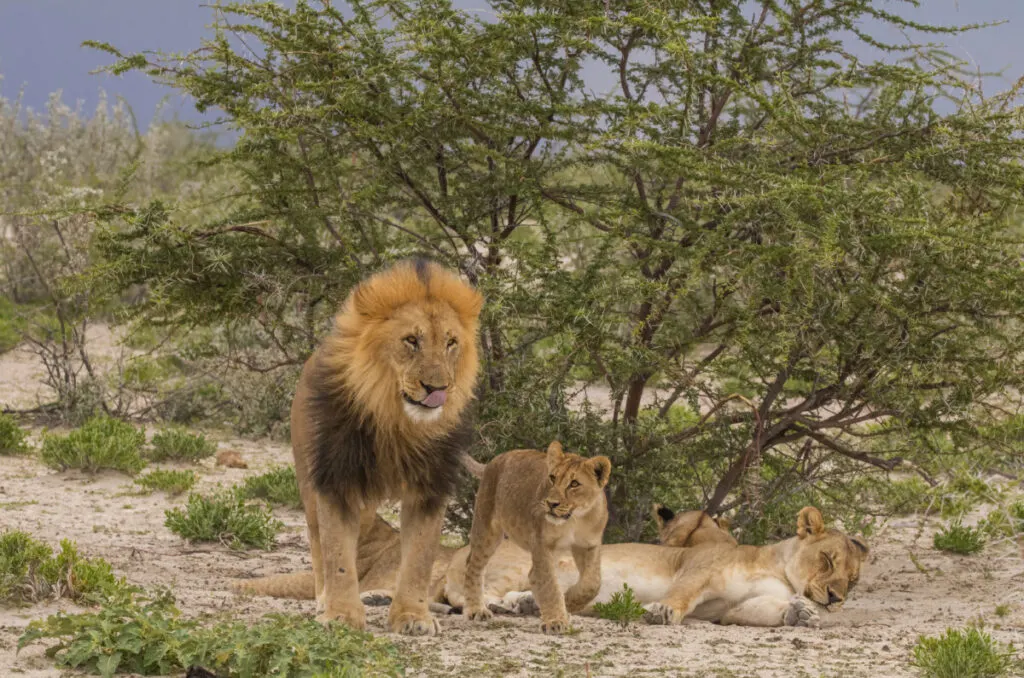
African lions exhibit a complex array of crucial behaviors for their survival. Their conduct varies widely, including fundamental ecological activities, intricate social interactions, and specialized adaptations to cope with human-impacted environments.
- Territorial Defense: They are fiercely territorial, often marking their space with roars and scent markings to warn rivals.
- Hunting: Lions are predominantly nocturnal hunters, with females typically spearheading group hunts.
- Adaptation: In human-dominated landscapes, lions adapt their movement to avoid conflict, sometimes selecting specific habitats depending on their behavior, such as hunting or resting.
- Group Dynamics: Socially, lions live in prides, a familial unit typically led by a dominant male, fostering strong social bonds among members.
- Communication: They communicate through a variety of vocalizations, body language, and visual cues, which serve to coordinate hunting, express dominance, and maintain social cohesion.
In areas where their habitats overlap with human activities, adjustments in their behavior have been observed, such as altered hunting methods and times to minimize human conflict. Understanding these behaviors is key to effectively conserving the species within ever-changing environments.
Lion Prides and Hunting Dynamics
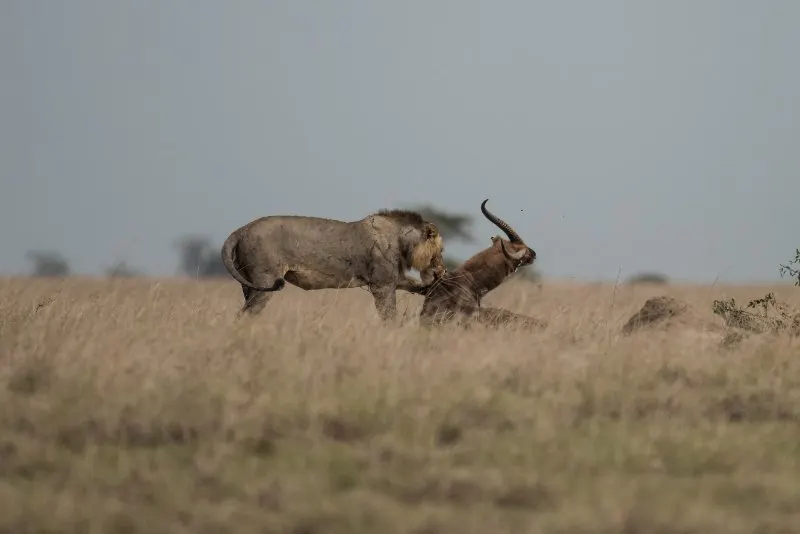
Lions are powerful hunters but have small hearts for their size, meaning they do not have the long-distance stamina that other hunters possess. Instead, they attempt to creep to within 30 meters of their prey, using the cover of darkness to hide their approach before making a sudden rush.
Wildebeests, buffalo, zebra, impala, and warthogs are all taken, but wildebeests are the preferred food of these great cats, making up around half of their diet.
Lions kill much of the time by biting the throat, rapidly suffocating their prey. Strong, well-protected animals like elephants, rhinos, and hippos, as are fast-moving gazelles, are usually safe from a lion’s roar or attack.
Lions stand unique among felines, forming socially complex groups known as prides. Typically, a pride young lion consists of a few males, numerous related females, and their cubs. The social structure of pride hinges on each member’s role in the group’s survival.
Male lions are tasked with the defense of the pride’s domain. They employ vocal intimidation and olfactory markers to maintain control of their established territories. Females, on the other hand, are the coalition’s lead hunters. They use sophisticated group strategies to outmaneuver faster prey, such as:
- Zebra
- Wildebeest
- Antelope
The collective hunt emphasizes the importance of cooperation. Cubs, however, receive the smallest portion during the division of the hunt’s bounty and only begin to contribute to lion hunting and endeavors after their first year.
Though lionesses spearhead the hunt and communally nurture their offspring, lions are not opposed to solitary hunting given the opportunity, nor are they above scavenging from others, such as hyenas.
The survival and propagation of lion populations largely depend on this intricate balance between group cooperation and individual roles, ensuring that each pride member fulfills their function in maintaining the collective’s health and territory integrity.
Perils Impacting Lion Continuity
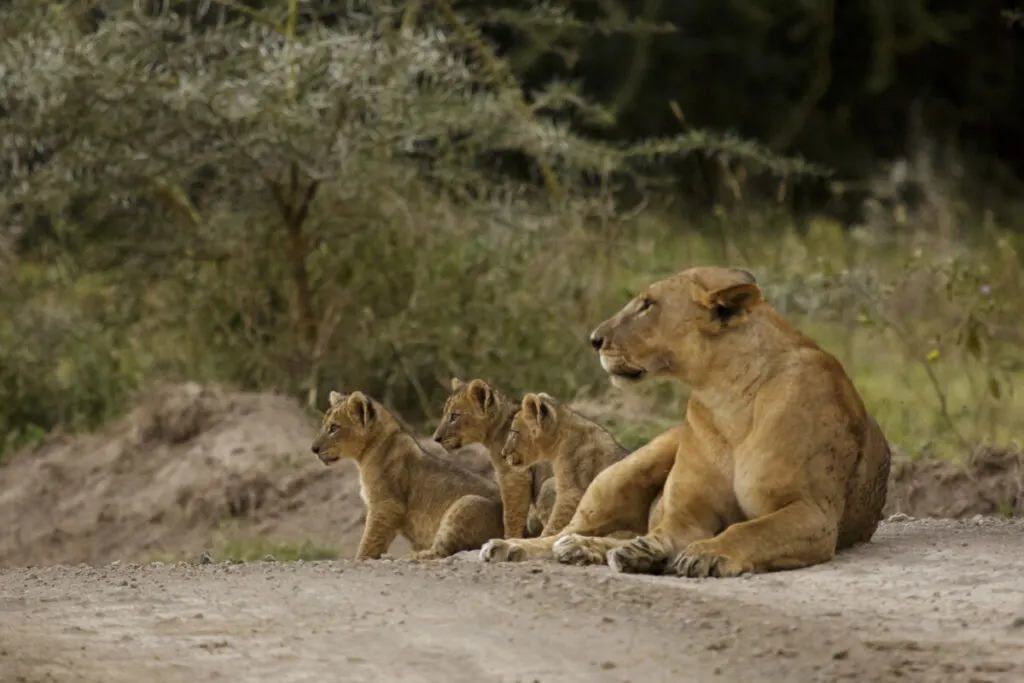
African lion populations have dwindled significantly, raising fears for their long-term survival. Factors contributing to this decline are manifold, with human activities featuring prominently. The human-lions conflict escalates predominantly around farmlands where lions are considered threats to livestock, leading to retaliatory killings. Furthermore, lions are subjected to poaching due to demand for their parts in the illegal wildlife trade.
The practice of trophy hunting remains contentious. Its management failures have historically led to local extirpations, casting doubt on its benefits for conservation efforts. Amidst this debate, habitat loss and decreasing wild prey—due to the escalating wildlife trade—force lions to predate on domesticated animals. This exacerbates the already tense human-wildlife dynamics, increasing the likelihood of human retaliatory hunts.
Conservation status: The International Union for the Conservation of Nature (IUCN) lists African lions as vulnerable, pinpointing the urgency of addressing these challenges to avert a slide into endangerment or possible extinction. With just under 25,000 individuals estimated to remain in the wild, the situation is a race against time to mitigate threats and safeguard the future of this majestic species.
Preservation Efforts for Lions
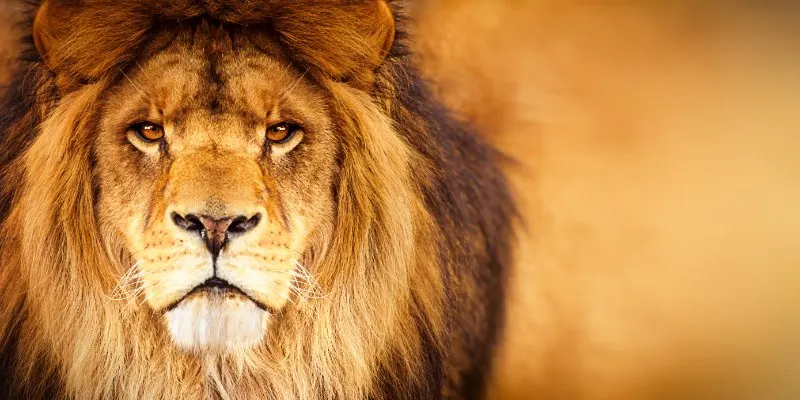
Efforts to ensure the coexistence of lions and humans are crucial for the big cats’ survival. Conservation programs are transforming attitudes by compensating communities when local lion numbers increase. Such initiatives also assist farmers whose livestock fall prey to lions.
Establishing protected habitats has gained traction. For example, after converting Selinda in Botswana into a sanctuary, lion numbers there have surged from a solitary pair to around one hundred individuals, thanks to the efforts of conservationists Dereck and Beverly Joubert.
The revival human lion conflict in Mozambique’s Zambezi Delta is noteworthy, with a substantial number of lions introduced from South Africa breeding successfully post-relocation after the region’s lion population was decimated due to prolonged civil turmoil.
Through such measures, conservationists aim to improve the conservation status of lions, moving them away from vulnerable classifications on the IUCN Red List and expanding their presence in protected areas.
African lions are the second largest big cat species in the world. Males can weigh up to 250 kg (550 lb) and females up to 150 kg (330 lb). They range across most of Africa, except dense rainforests and deserts.
Lions have been classified as endangered, with only about 20,000 animals remaining in the wild. Reasons for their decline include habitat loss, disease, and conflict with humans. Conservationists are working hard to save this iconic animal from extinction.
See Related: Types of Lions Around the World
Pride structure
African lions live in pride, family, or clan groupings, including one to three males and perhaps ten or twelve females, plus cubs. These large social units are needed for cooperative hunting since many of the prey species. African lions are large, robust animals that need several cats working together to bring them down.
The speed of other prey animals requires cooperative ambush tactics to have any chance of regular success in capturing them.
Lionesses do much of the hunting, though adult males sometimes participate and perform the critical task of defending the pride’s territory from intruders.
Male lions also protect the cubs while the lionesses are hunting. Young males are usually ejected from the pride when they grow large enough and live alone or with one of pride females or their brothers for companionship. These youths attempt to take over existing pride or form a new one with nomadic females.
See Related: Asian Lion
Conservation
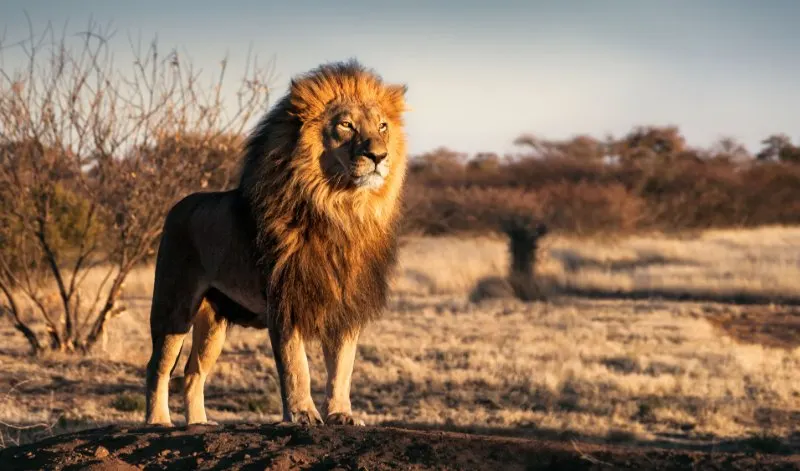
Conservation efforts
Large parks and reserves are the best conservation hope for lions, though even more area is needed, and better protection is urgently required for the existing areas.
Many organizations, such as the Lion Conservation Fund, also attempt to reduce the conflict between humans and lions (which the lions inevitably lose) through education and establishing wildlife protection corridors.
See Related: Environmental Organizations in Africa
Conservation Organizations
Botswana Predator Conservation Trust

Botswana Predator Conservation Trust has studied African predators, including lions, since 1989 to understand their territories and limit their conflicts with humans.
See Related: Fastest Animals in the World
Call from the Wild
Call from the Wild is an organization started by the Frankfurt Zoological Society, which supports various national parks throughout Africa to protect endangered species, including lions.
Panthera

Panthera is an American-based organization. Their main focus is to conserve the world’s largest wild cats, including the African Lion, by supporting research and education programs in different countries.
Wildlife Conservation Society

Wildlife Conservation Society was formed in 1895 to protect 25 percent of the world’s biodiversity by promoting the importance of protecting wildlife and their habitats. WCS has two national parks and five zoos in New York.
Related Resources
